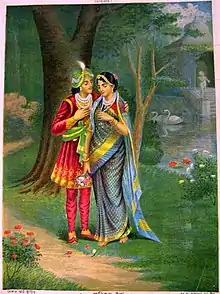Uṣā
Uṣā or Usha (Sanskrit: उषा) was a daughter of the asura king Banasura and wife of Annirudha, grandson of Lord Krishna.[1]
| Uṣā | |
|---|---|
.jpg.webp) Usha dreaming of Aniruddha | |
| Texts | Bhagavat Purana, Vishnu Purana, Shiva Purana, Mahabharata |
| Personal information | |
| Born | |
| Parents |
|
| Spouse | Aniruddha |
| Children | Vajra |
Marriage
According to the legends, Usha was a daughter of Banasura, the powerful asura king of Sonitpur. Banasura was a great devotee of the Lord Shiva and had 1000 arms. Just like her father Usha was also a devote to Shiva and Parvati. Once Usha asked Parvati who her husband would be. Parvati replied "In the month of Baishakh a person would appear in your dreams. That would eventually be your husband."[2]

One day, Usha saw a young prince in her dream and fell in love with him. That prince was Aniruddha, the grandson of Lord Krishna and son of Pradyumna. Usha's friend Chitralekha, through supernatural powers abducted Aniruddha from the Dwarka and brought him to Usha.[3]
When Krishna got to know about it, he came with a huge army and attacked Banasura's kingdom Sonitpur. Bana also attacked Krishna’s army with equal might, but he began to feel powerless in front of Lord Krishna. Thus, he evoked Lord Shiva to take his side. At this point, Shiva joined the battle against Krishna because he had promised protection to Banasura. Krishna himself defeated Shiva with a weapon that put Shiva to sleep. After that Krishna cut Bana's thousand arms systematically. Seeing Krishna releasing his Sudarshan Chakra to sever his head, Shiva aroused from his slumber, approached Krishna and asked him to spare Bana’s life. After that Krishna forgave Bana.[4]
After the war, Usha married Anirudha. Later Usha gave birth to a son named Vajra. However he is sometimes referred as the son of Aniruddha's first wife, Rochana.[5]
Rebirth
According to Shiva Purana, Usha and Annirudha were reborn as Behula and Lakshindar in the next life and married each other again.[6]
In popular culture
The story of Aniruddha and Usha (as Okha in Gujarati) is depicted in the 18th century Gujarati Akhyana entitled Okhaharan by Premanand Bhatt.[7]
A 1901 Telugu language play titled Usha Parinayam written by Vedam Venkataraya Sastry was based on story of Usha.[8] The play was also taken as a Telugu film in 1961 by Kadaru Nagabhushanam under Rajarajeswari films.
Usha Kalyanam is a 1936 Tamil-language film directed by K. Subramaniam.
References
- Fables and Folk-tales of Assam. Firma KLM. 1998.
- Chaturvedi, B. K. (2 January 2017). Vishnu Puran. Diamond Pocket Books Pvt Ltd. ISBN 978-93-5083-749-8.
- Bhagat, Dr S. P. (18 September 2016). Shrimad Bhagavata Purana. Lulu Press, Inc. ISBN 978-1-365-40462-7.
- Bhandari, C. M. (1995). Saving Angkor. White Orchid Press. ISBN 978-974-89229-4-2.
- Dalal, Roshen (18 April 2014). Hinduism: An Alphabetical Guide. Penguin UK. ISBN 978-81-8475-277-9.
- McDaniel, June (5 August 2004). Offering Flowers, Feeding Skulls: Popular Goddess Worship in West Bengal. Oxford University Press. ISBN 978-0-19-029056-6.
- Sen, Siba Pada (1988). Sources of the History of India. Institute of Historical Studies.
- Leiter, Samuel L. (2007). Encyclopedia of Asian Theatre: A-N. Greenwood Press. ISBN 978-0-313-33530-3.